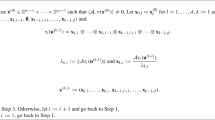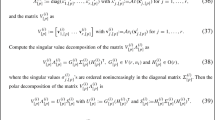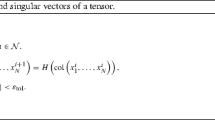Abstract
Tensor methods for nonlinear equations base each iteration upon a standard linear model, augmented by a low rank quadratic term that is selected in such a way that the mode is efficient to form, store, and solve. These methods have been shown to be very efficient and robust computationally, especially on problems where the Jacobian matrix at the root has a small rank deficiency. This paper analyzes the local convergence properties of two versions of tensor methods, on problems where the Jacobian matrix at the root has a null space of rank one. Both methods augment the standard linear model by a rank one quadratic term. We show under mild conditions that the sequence of iterates generated by the tensor method based upon an “ideal” tensor model converges locally and two-step Q-superlinearly to the solution with Q-order 3/2, and that the sequence of iterates generated by the tensor method based upon a practial tensor model converges locally and three-step Q-superlinearly to the solution with Q-order 3/2. In the same situation, it is known that standard methods converge linearly with constant converging to 1/2. Hence, tensor methods have theoretical advantages over standard methods. Our analysis also confirms that tensor methods converge at least quadratically on problems where the Jacobian matrix at the root is nonsingular.
Similar content being viewed by others
References
A. Bouaricha, “Solving large sparse systems of nonlinear equations and nonlinear least squares problems using tensor methods on sequential and parallel computers,” Ph.D. dissertation, Department of Computer Science, University of Colorado (Boulder, CO, 1992).
A. Bouaricha and R.B. Schnabel, “A software package for tensor methods for nonlinear equations and nonlinear least squares,” in preparation.
D.W. Decker, H.B. Keller and C.T. Kelley, “Convergence rate for Newton's method at singular points,”SIAM Journal on Numerical Analysis 20 (1983) 293–314.
D.W. Decker and C.T. Kelley, “Newton's method at singular points I,”SIAM Journal on Numerical Analysis 17 (1980) 66–70.
D.W. Decker and C.T. Kelley, “Newton's method at singular points II,”SIAM Journal on Numerical Analysis 17 (1980) 465–471.
D.W. Decker and C.T. Kelley, “Convergence acceleration for Newton's method at singular points,”SIAM Journal on Numerical Analysis 19 (1981) 219–229.
J.E. Dennis Jr. and R.B. Schnabel,Numerical Methods for Unconstrained Optimization and Nonlinear Equations (Prentice-Hall, Englewood Cliffs, NJ, 1983).
J.J. Dongarra, J.R. Bunch, C.B. Moler and G.W. Stewart,LINPACK Users Guide (SIAM, Philadelphia, PA, 1979).
P.D. Frank, “Tensor methods for solving systems of nonlinear equations,” Ph.D. dissertation, Department of Computer Science, University of Colorado (Boulder, CO, 1982).
A. Griewank, “Analysis and modification of Newton's method at singularities,” Ph.D. dissertation, Australian National University (Canberra, ACT, 1980).
A. Griewank, “On solving nonlinear equations with simple singularities or nearly singular solutions,”SIAM Review (1985) 537–563.
A. Griewank and M.R. Osborne, “Analysis of Newton's method at irregular singularities,”SIAM Journal on Numerical Analysis 20 (1983) 747–773.
C.T Kelley and R. Suresh, “A new acceleration method for Newton's method at singular points,”SIAM Journal on Numerical Analysis 20 (1983) 1001–1009.
J.M. Ortega,Numerical Analysis (Academic Press, New York, 1972).
G.W. Reddien, “On Newton's method for singular problems,”SIAM Journal on Numerical Analysis 15 (1978) 993–996.
R.B. Schnabel and T. Chow, “Tensor methods for unconstrained optimization using second derivatives,”SIAM Journal on Optimization 1 (1991) 293–315.
R.B. Schnabel and P.D. Frank, Tensor methods for nonlinear equations,”SIAM Journal on Numerical Analysis 21 (1984) 815–843.
G.W. Stewart, “Error and perturbation bounds for subspaces associated with certain eigenvalue problems,”SIAM Review 15(4) (1973) 727–764.
Author information
Authors and Affiliations
Additional information
This paper is dedicated to Phil Wolfe on the occasion of his 65th birthday.
Research supported by AFOSR grant AFOSR-90-0109, ARO grant DAAL 03-91-G-0151, NSF grants CCR-8920519 CCR-9101795.
Rights and permissions
About this article
Cite this article
Feng, D., Frank, P.D. & Schnabel, R.B. Local convergence analysis of tensor methods for nonlinear equations. Mathematical Programming 62, 427–459 (1993). https://doi.org/10.1007/BF01585177
Received:
Revised:
Issue Date:
DOI: https://doi.org/10.1007/BF01585177




